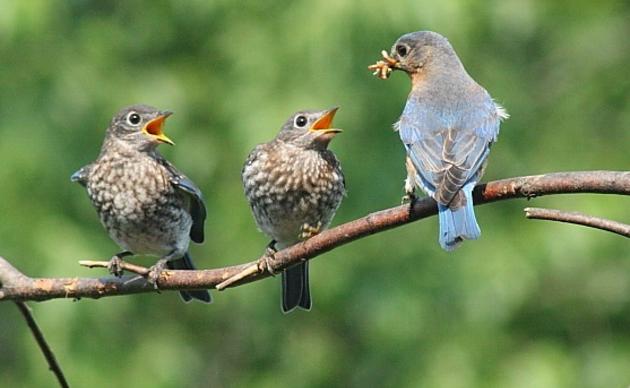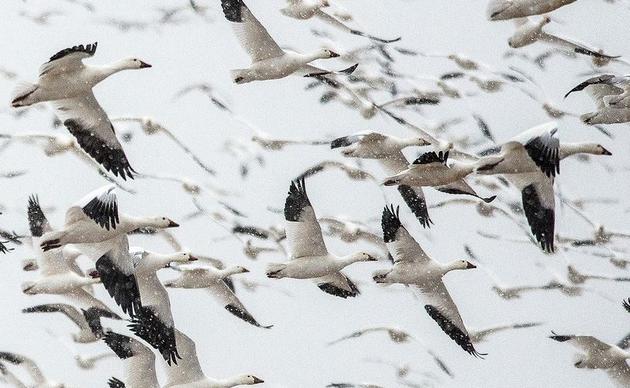Original story posted by the Register-Star by Jim Planck, Columbia-Greene MediaPosted
Friday, February 19, 2016
One of the enjoyments of spring in the Northeast is that it’s nesting season for the birds, so that bushes and trees, grasses and reeds, and even just plain gravel and stone, become home to hard-working parents supplying their young with the food of choice. People have long enjoyed watching that nesting cycle, and the ability to participate in it can be as simple, or as complicated, as the individual chooses.
It’s simply a matter of deciding what species you want to attract, and — given the type of surroundings the box will be placed in — ensuring that species is likely to be present or has been observed there, and then building the box and setting it out.
However, that last step — placement of the box — is a key factor in whether the box will be successful in attracting residents, which is not to say your birdhouse won’t be lived in if it’s improperly placed, only that it lessens the chance it will be used by the species you intend, or be used at all.
Palenville resident Larry Federman, president of Northern Catskills Audubon Society, the national society’s local chapter, uses the well-known real estate mantra to stress the importance of placement.
“It’s all a matter of location, location, and location,” said Federman, adding that the box’s design is equally significant. “The two important things are the size of the box and — just as important — is the size of the opening.”
“Just because you’ve put a box up,” said Federman, “doesn’t mean you’re going to get a resident. When we put up a box we’re just providing an appropriate opportunity for them, but if there’s naturally occurring (tree) cavities, they’re going to go for them first. And don’t be discouraged,” he added.
There is also a timeframe for erecting nest boxes, as they should be in place before the species needs them, and that criteria depends on when they nest, which is, in turn, based on whether they’re a year-round species or a migrant species.
Some migrants, like the Eastern bluebird, are early returners, so the box is best placed no later than mid-March, but as they often have two broods, missing the first one does not mean you won’t have a bluebird family nesting in your box later in the season.
Federman said not to wait, or try to time box placement for the second brood, but to place it as soon as you can. “Get it up immediately, even if you miss it (the first brood),” he said. “And for bluebirds, it’s important to put the boxes up in pairs, no further than 10 feet apart.” He said that allows another attractive, but competing, species for nest boxes -- the tree swallow -- to use one box and defend the other box from use by a second tree swallow pair, thus leaving it open and safe for the bluebirds. In short, if you space single boxes further than 10 feet apart, you’re likely to get each one filled by tree swallows and no bluebirds.
Bluebirds are, of course, the state bird and are beloved by all -- you can even get one on your license plate with an image by the late renowned bird artist Roger Tory Peterson. Bluebird nesting box trails, like the 400-plus box network monitored by Dutchess County’s Ralph T. Waterman Bird Club, are also extremely popular, and help sustain the growing bluebird population against foreign species, like starlings, who were one of the factors in the bluebird’s decline during the middle of the 20th century.
Federman said one way of eliminating false expectations when putting out a nesting box is to ensure the bird species you want is actually present. Using screech owls as an example, he explained, “If you’ve heard screech owls, you know they’re in the area. But they might not use it as a nest box. It might be used as a (daytime) roost box, a place for protection from other birds that don’t want him around, and from the elements.”
Federman said several cavity nesting species need the public’s assistance in providing homes, one such being the American kestrel, a beautifully patterned small falcon and formerly known as the sparrow hawk.
“Ornithologists and local birders have noted a decline in kestrel populations,” he said, “both in breeding and in wintering populations. One factor suspected in contributing to this is a lack of appropriate nesting opportunities.”
Federman said the chimney swift, which literally nests inside chimneys, flies at dusk with a melodic chittering call, and who’s wing movement creates the illusion they’re not moving in unison, but alternately, is also experiencing a population decline.
“It’s because of a lack of appropriate chimneys for nesting,” he said, adding that Audubon New York Director of Operations Rich Merritt has a project that constructed and installed artificial chimneys, called towers, at several Capital District locations. Merritt initiated his project in 2012, and was, in fact, awarded a “TogetherGreen Fellowship” from Toyota Corporation to do so, and he put up three towers in parks in Albany and Troy, each of which can provide habitat for up to 150 swifts.
For ultra-serious birders with construction or contractor skills and thinking about helping swifts, the Texas-based Chimney Swift Conservation Association, at its website www.chimneyswifts.org, has not only a great deal of information on the species, but tower construction photos and a video as well.
Another communal or colony nester that Federman said is experiencing a population decline is the purple martin, noting that there has been some success in central New York with martin houses, as well as at the Shawangunk Grasslands National Wildlife Refuge, in Ulster County.
He said one technique that some locations use is that when the birds pass by during migration, recordings of their songs and calls are played, successfully attracting them to the martin house. The house itself is multi-chambered and could perhaps be more correctly termed an apartment complex.
Martins also like gourds as homes, and Federman said a number of gourds appropriately placed and prepared can also be used. For those who travel the Thruway in the mid-Hudson Valley, a well-known and long successful purple martin colony is established and can be seen along the entrance road to the Exit 18 toll booths, in New Paltz.
Federman said that no matter what type of box you build and place, however, keep it maintained after each use, stressing, “Make sure to clean out the boxes between broods and after the season.”
Wood ducks, one of the most attractive waterfowl, are also a popular species for nest boxes, with sportsmen’s clubs often assisting in the production and distribution of homes for them. Columbia County Sportsmen’s Federation is one such organization, and CCSF President Jim Bashford said the well-loved program has been ongoing for a decade.
“In the past 10 years,” said Bashford, “the program has supplied probably 15 or 20 boxes each year, so it’s anywhere from 150 to 200 boxes over that time.”
Bashford said the federation purchases the lumber and then a member or members volunteer time to build the boxes, after which they are distributed.
“We give them out to different clubs,” he said. “There’s 32 clubs in the county,” citing in example Kinderhook Sportsmen’s Club, Ghent Sportsmen’s Club, Canaan Conservation Club, and Germantown Sportsmen’s Club.
Greene County Federation of Sportsmen’s Clubs President Bob Monteleone said the Federation formerly had a wood duck box program, with Rip Van Winkle Lake, in Tannersville, and the beaver ponds upstream from that, in Gooseberry Creek, as two of the locations where boxes were placed.
Ducks Unlimited volunteer Dana Hanusik, who coordinated that effort as a member group of the Federation, said it wound down through lack of participation. “We don’t have the people or the programs as much as we want to,” Hanusik said. “When we get a chance to get some of the young kids together, I plan on looking at it again.” Local outdoor columnist Dick Nelson noted that it worked really well.
“That was an excellent program,” Nelson said. “I’ve got two of them on my property, by my pond.”
The above species are just a few of the many birds that can take up housekeeping in a nesting box, but -- again -- the entry hole must be the correct dimension for the intended species, and it must be placed suitably, by species, in the right habitat, which includes factors like correct elevation and distance from or within surrounding growth.
Other cavity nesters you may hope to attract include the chickadee, downy and hairy woodpecker, white-breasted and red-breasted nuthatch, tufted titmouse, flicker, crested flycatcher, wren, saw-whet owl, barn owl, merganser, and the house finch, the last being a western species that were introduced as cage birds to Long Island in the 1940s, released or escaped, and has since become regularly established throughout much of the Northeast. Additionally, some birds, like the robin, phoebe, and barn swallow will nest on a suitably man-made nesting shelf.
English house sparrows, introduced in 1851, and European starlings, introduced in 1890, are now widespread and will also nest in cavity boxes, but unfortunately displace the desired species unless the entrance hole is designed properly. Predators reaching into the box are also a concern, so nesting box instructions typically have safeguarding instructions as well.
For those seeking nesting house plans, they are readily available, with Audubon’s Federman noting that Cornell University’s Laboratory of Ornithology has a website called nestwatch.org which has a treasure trove of information and plans about nest boxes and nesting structures, like shelves. There are many, many other education-based sites on the web, as well as books at area libraries and bookstores, that also offer plans and information, so learning about the wealth of background information available and selecting what bird to attract can be half the fun of putting out a box. So have fun, and happy birdwatching.



